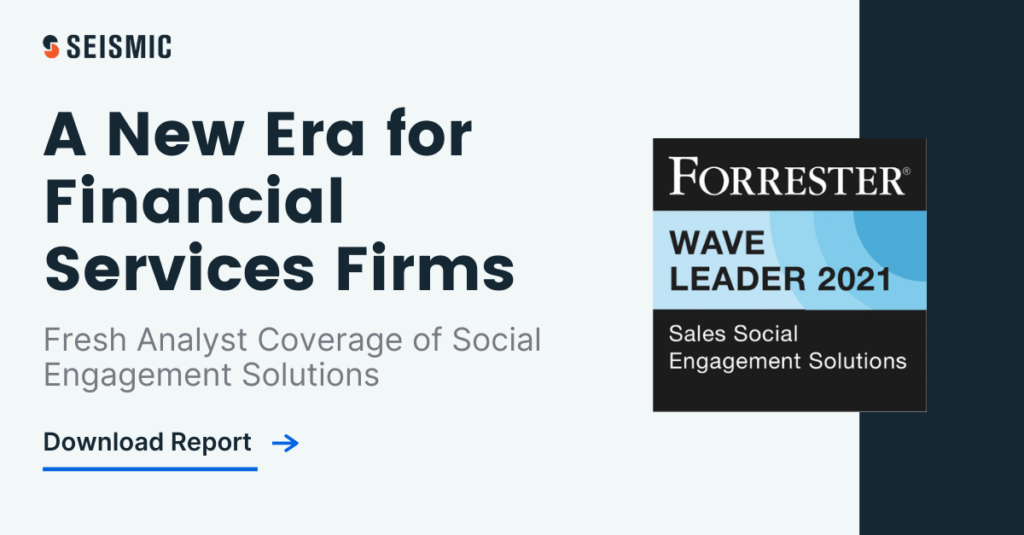A lot has changed since the first forward-thinking banks, insurance companies, and wealth management firms began to grapple with the risks and the rewards of social media.
Early innovators recognized the opportunity to enable their people to grow their relationships and businesses while elevating the corporate brand by engaging on LinkedIn, Facebook and Twitter. They also recognized that enabling a social program is fraught with risk in regulated industries.
They sought out – and found – tools that would provide some resolution to the two primary challenges in a social enablement program:
Curating content at scale
They need access to current, relevant 3rd-party content because they know that if all their people ever share is their brand’s own promotional content, engagement will be sparse.
They also know that manually curating quality content is extremely time consuming. It can’t be left to each advisor or agent to curate their own, and building a sizable curation team within the marketing department is prohibitively expensive.
Compliance
Failure to ensure all social media activity is compliant is not an option. They must supervise their people’s social profiles, the content they share and the comments they make. In many parts of the financial services world, everything also needs to be archived.
Manual oversight poses two primary problems. It’s slow – preventing their people from sharing timely content and engaging in online conversations in real time – and it’s expensive. Much like the challenges of scaling a curation team, a large human oversight team is a very costly endeavor.
Legacy social engagement platforms to the rescue
The first generation of platforms did a workable job on both of these fronts.
They allowed marketing to curate content into libraries of various sorts to be shared as needed. Individual users didn’t have to search for what to share but didn’t have much choice either.
These early platforms also helped reduce the burden on compliance teams as they flagged various troublesome language including profanity, contentious political or religious talk, mention of competitors, and some of the most obvious promissory statements and met the basic archive requirements.
But problems emerged
Firms that invested in these legacy platforms got the jump on their competition. While their rivals were attempting to keep their people off of social entirely – or severely curtailing their ability to do or say anything of consequence – these firms built the first social programs in their industries.
And as these programs began to mature, their limitations became increasingly clear.
- Lookalike sharing. Multiple people from the same firm regularly share the same content, often with the same introductory comments. Often advisors would go on autopilot. It’s a bad look. It looks robotic. Scripted. Anything but authentic.
- Problems scaling. The more successful a program was, the more demand for unique content which required more and more curators. The more social activity, the more false positives which created huge headaches for supervisors.
- Low audience engagement. Lookalike sharing and limited real-time conversation on social results in low levels of audience engagement. Readers don’t feel compelled to read yesterday’s news nor to attempt a conversation with someone who struggles to respond.
- Low adoption. Not surprisingly, low audience engagement makes it difficult to sustain user engagement. Posting on social often feels like something that financial services professionals “should” do more than something that they want to do. With countless other demands on their time and attention – and despite the ongoing training and encouragement efforts of program administrators – few see the benefit of remaining active and growing their social footprint.
- Questionable business value. All of these limitations combine with a gap in a method to measure business impact to raise hard questions every year for marketing on the value of investing in social.
What got you here won’t get you THERE
Executives and program leaders know that social media *is* here to stay, *does* present a huge opportunity, and being outperformed by their competitors presents untenable risks.
They’re also suffering through all the above-mentioned challenges – and others too – on the road to building, scaling, optimizing and measuring their programs.
They know they need to build on early foundations by upgrading their capabilities in meaningful ways.
Great news awaits in The Forrester Wave™: Sales Social Engagement Solutions, Q1 2021 report, released March 10, 2021.
Seismic’s Scores
In the Forrester report, Seismic LiveSocial (formerly Grapevine6) received the following criteria scores:
- Content (4.20/5.0)
- User Experience (4.20/5.0)
- Services (5.0/5.0)
- Product Vision (5.0/5.0)
- Category Vision (5.0/5.0)Execution and Product Roadmap (5.0/5.0)
The dawn of a new era
It’s the dawn of a new era for financial services firms. Their people can now show up on social media with confidence and purpose, build relationships, and grow their book of business. And their compliance teams and executives can sleep very well at night.
Now is not the time to sleepwalk into renewing reliance on legacy platforms. Now is the time to take programs to the next level.
Four of North America’s five largest wealth management firms are using LiveSocial and building substantial competitive advantage.
We’re here to help.
Read The Forrester Wave™: Sales Social Engagement Solutions, Q1 2021 here.
Learn more about Seismic LiveSocial and request a demo here.
